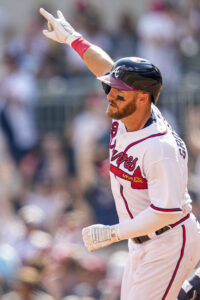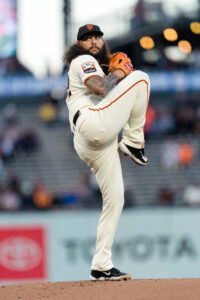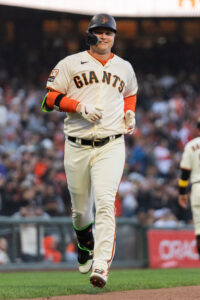Spring training is ramping up this week but the offseason isn’t done. Seven of MLBTR’s Top 50 Free Agents remain unsigned, including one big fish in Alex Bregman, as well as plenty of mid-rotation starters.
Jakob Junis is one pitcher we considered for the list but who just missed the cut. The righty hasn’t appeared in any rumors of note this winter. MLBTR hasn’t written about him since he declined his end of a mutual option and became a free agent at the start of November.
The righty was a free agent last winter as well and agreed to a deal with the Brewers almost exactly one year ago. Reports emerged on February 5 of 2024 that he would sign a one-year deal with Milwaukee, a $7MM guarantee.
It took a bit of time for his season to get momentum. He made one appearance in early April before landing on the injured list due to a right shoulder impingement. His return was delayed by a scary fluke incident. He was doing some on-field jogging during batting practice before a game when he was struck by an errant ball. He didn’t come off the IL until late June.
After coming off the IL, he pitched multi-inning relief outings for the Brewers. But just over a month after being reinstated, he was flipped to the Reds as part of the deadline deal which sent Frankie Montas to Milwaukee. He pitched out of the Cincinnati bullpen for a while but moved to the rotation down the stretch as that club dealt with a number of injuries and was playing out the string on the season.
Despite the delayed ramp-up and the midseason change of scenery, Junis still managed to log some good numbers on the whole. He made 24 appearances, including six starts, throwing 67 innings. He allowed just 2.69 earned runs per nine frames. He got a bit of help from a .224 batting average on balls in play and a 77.9% strand rate, but his 3.69 FIP and 3.72 SIERA suggest he still would have been effective even with neutral fortune from the baseball gods. His 20.2% strikeout rate was down a bit from the year prior but he also dropped his walk rate all the way to a miniscule 3.2%.
That’s now four straight seasons of pretty decent production from Junis. Over the 2021 to 2024 campaigns, he made 33 starts and 70 relief appearances. In that time, he posted a 3.99 ERA, 22.6% strikeout rate and 5.2% walk rate. Control is clearly a strength, as he’s never finished a season with a walk rate higher than 7.5%. His strikeout rates have been fairly average, but he has occasionally found an extra gear in that department. He punched out 24.4% of opponents in 2021 and 26.2% in 2023, though he was down closer to 20% in 2022 and 2024.
In terms of his arsenal, his four-seamer and sinker averaged around 92 miles per hour last year, though he also threw a slider, changeup and cutter. The slider has been his most important weapon, as he has thrown that more than any other pitch in each of the last five seasons. The Stuff+ metric has given the pitch a grade around 110 pretty consistently for the past five years and he averaged 13.4 inches of horizontal break on it in 2024, per Statcast, putting it 11th among sliders from qualified pitchers last year in that department. Hitters generally put up batting averages around the Mendoza line against it, including a slash of .183/.230/.346 last year.
Junis doesn’t have notable concerns in his splits. As a right-hander, lefties have hit him better, but not drastically so. He has allowed a line of .286/.340/.473 without the platoon advantage in his career, only a bit better than his .248/.300/.430 line allowed to righties.
He’s also capable of putting up decent numbers from both the rotation or the bullpen. As a starter over the past four years, he has a 3.76 ERA, 22.4% strikeout rate and 5.1% walk rate. As a reliever in that span, he has a 4.22 ERA that seems inflated by a .332 BABIP, as his 22.8% strikeout rate and 5.3% walk rate are very similar to his rotation work.
Based on the quiet winter, it’s possible that Junis will wind up with a similar deal to the $7MM guarantee he got last winter. In the past month or so, Michael Lorenzen, Martín Pérez and Colin Rea have signed one-year deals in that range, with Lorenzen getting $7MM and the other two getting $5MM. Here are the numbers for those guys over the past two years, with that range selected because Rea was pitching in Japan in 2022:
- Junis: 153 innings, 3.35 ERA, 23.7% strikeout rate, 4.7% walk rate
- Lorenzen: 283 1/3 innings, 3.78 ERA, 17.9% strikeout rate, 9.2% walk rate
- Rea: 292 1/3 innings, 4.40 ERA, 19.9% strikeout rate, 6.6% walk rate
- Perez: 276 2/3 innings, 4.49 ERA, 16.7% strikeout rate, 8.2% walk rate
Junis has a lower innings tally than everyone in that group, due in part to his injured list stint in 2024 and because the Giants mostly used him out of the bullpen in 2023. But on a rate basis, he’s been clearly a cut above those recent back-end starters/swing guys that have signed lately. Plenty of clubs still need pitching help and injuries will surely be discovered in the coming weeks as pitchers ramp up in camp. If some club goes out looking for late-winter bargains, Junis seems like a good candidate.



